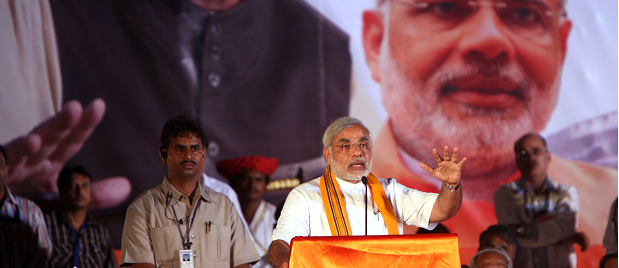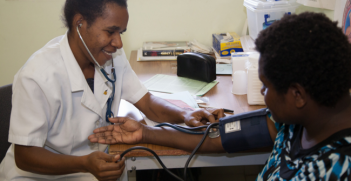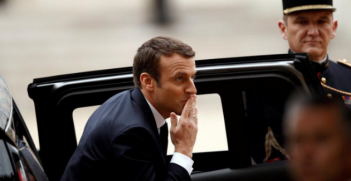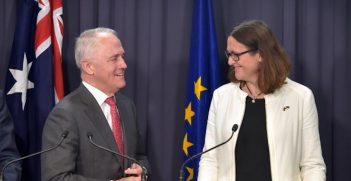The Great Indian Election

Democracy was deemed unlikely for India as the country’s grinding poverty and the diversity of its ethnic, religious, caste and linguistic identities were thought to be insurmountable obstacles. Yet nearly seven decades later, flanked by unstable countries in its immediate neighbourhood, a system of parliamentary democracy thrives in India.
Elections 2014
The election for the 16th Lok Sabha (House of the People, the lower House of Parliament) began on April 7 and voting is being held on 10 dates across the country until May 12. The Lok Sabha has 543 seats that are filled by election, plus two seats to which representatives from the Anglo-Indian community are nominated by the President of India. The results will be announced on May 16.
The Election Commission of India, an autonomous statutory body with powers established by the Constitution, conducts the entire electoral exercise. This time it is overseeing an election in which there are 815 million registered voters of which over 100 million are new voters. The mindboggling logistics include the deployment of 11 million poll and security personnel at 830,000 polling stations.
Parties, candidates and issues
The main parties fighting for power in this election are the Congress and its allies under the banner of United Progressive Alliance (UPA) and the Bharatiya Janata Party and its allies, known as the National Democratic Alliance (NDA). In addition, there are a host of regional and other smaller parties in the fray.
The UPA has come into this election as an underdog. After 10 years or two terms as the ruling party, it is suffering severely from the effects of incumbency. In its second term Prime Minister Manmohan Singh’s Government has been seen as corrupt, lacking direction or purpose and, because of the scandals that surrounded it, unable to fulfil its policy objectives, either domestic or foreign. The Congress has not officially named an alternative but it is widely presumed to be Rahul Gandhi, scion of the Nehru-Gandhi dynasty, who is seen as lacking in vision, articulation and experience in a position of responsibility in government.
On the other side stands the NDA which is promising a strong, purposeful, dynamic government that will take the country’s economic growth to what it was and higher. The BJP’s prime ministerial candidate is the long-standing Gujarat Chief Minister Narendra Modi, who is credited with the economically transformation of that state. But his anointment came after months of internal struggle in the party. Some leaders in the party are uncomfortable with his reputation as a chief minister who did little to prevent riots in his state in 2002 in which more than 1000 people, mainly Muslims, were killed. But this dissension died as it became apparent that the BJP’s powerful ideological group, the Rashtriya Swyamsevak Sangh, was on Modi’s side. The RSS spearheads the idea of political Hinduism and Hindu nationalism, also known as Hindutva.
The Congress has projected this election as a battle for “the idea of India”, in which its own ideology and vision of a secular India is pitted against what it describes as BJP’s “divisive” politics. The BJP, on the other hand, has been playing down its ideological underpinnings and focusing its campaign on its “development agenda”.
Since 1998 national parties have not managed on their own to get the 51% of seats required to form government. If that trend continues in this election, in the event that the NDA emerges as the single largest combine but still falls short of the halfway mark, it will need to reach out to other parties.
After the results
Irrespective of which party or group forms the next government, the challenges facing it are formidable. India is the youngest country in the world. More than half its 1.3 billion population is under the age of 25 and has global aspirations. It is also a country with a fast expanding aspirational middle class, which in a few years could number more than 500 million people. Yet India still has one of the largest numbers of people living below the poverty line in the world.
Foreign policy does not figure high on the list of priorities during an election, but this is an area that will need the immediate attention of the next government. Relations with the United States, which underwent a strategic shift with the signing of the civilian nuclear accord, have stagnated. Relations with China, with which India has a border dispute, are at an impasse. So too are relations with Pakistan, which have never really made progress after the terrorist attacks in Mumbai in November 2008. As for the rest of the South Asian neighbourhood, India is viewed with suspicion and distrust – more so now than even five years ago.
The challenges before the new government are thus formidable both internally and externally. Domestically, managing the expectations of an increasingly impatient electorate will be no easy task for even the most astute government. Internationally, the new government faces an international system that is more divided than at any time since the end of the Cold War. Will India, as often in the past, muddle through these challenges without firm direction? Or will it descend into its most serious crises in its history as a modern independent nation? Or will it, for a change, navigate through these problems with clarity of purpose and direction? By early June, we should get the first signals of how India will cope with the next five years.
The Australia India Institute (AII) at the University of Melbourne is a leading centre for the study of India. Through its teaching, research, public policy and outreach programs it is building Australia’s capacity to understand India. For more commentary, see the AII’s Election Watch 2014 website.
A longer version of this article will appear in an AIIA Policy Commentary to be published in May.





